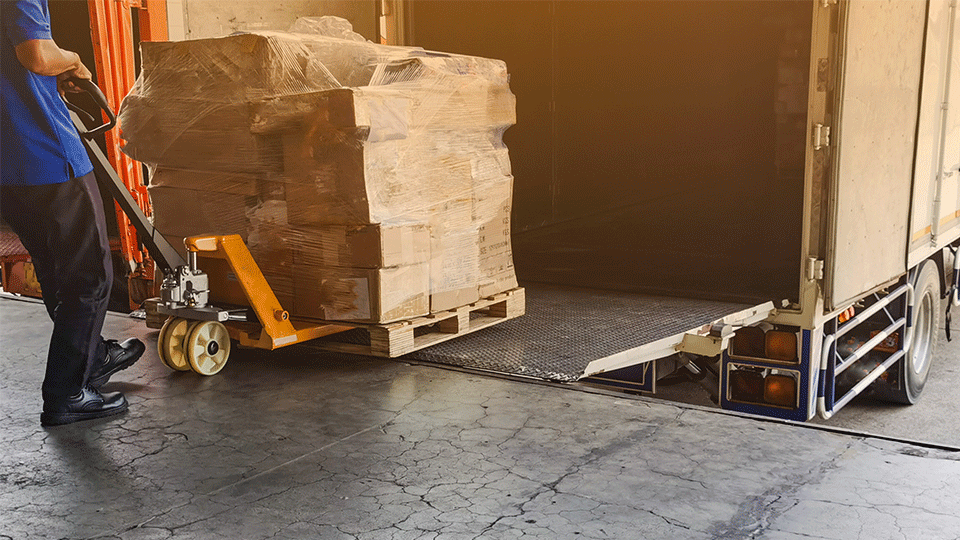
Most companies use pallets to ship their goods at some point or another. Be it for a one-off less-than-truckload shipment, or a full truckload dry van load, palletizing your products is a convenient way to prepare them for transport.
Provided you have a pallet jack or forklift at your disposal, loading and unloading palletized cargo can be done quite comfortably as well. With this equipment, you can load pallets from a loading dock, using a liftgate or from the side of an open-deck trailer.
Pallets are also relatively straightforward to secure in most situations, increasing their convenience for truck drivers.
If your company hasn’t ever used pallets to ship freight, or if you’re simply wondering about making a size change, you’re in the right place.
Here at Anderson Trucking Service (ATS), we’ve been helping businesses (across industries) ship their palletized freight for nearly seven decades. During this time, we’ve become intimately familiar with pallets large and small.
Understanding the common pallet sizes and constructions used for shipping freight will help you decide which is right for your cargo; the width and length of your pallets will influence the number you can ship in a 53-foot trailer.
To help you make this decision, this article will outline these key pallet-related facts:
- What types of pallets are used for freight shipping?
- What designs of pallets are commonly used in shipping?
- What are the standard pallet sizes?
- How much weight a pallet can hold?
- Why it matters which pallets you use
What Types of Pallets Are Used For Freight Shipping?
Pallets come in a variety of shapes, sizes and materials. Contrary to what you might think, this topic has some depth. While it’s possible to custom manufacture pallets in an array of materials — some companies even use paper pallets — most commonly, the pallets used to support and ship freight are either wood, metal or plastic.
Here’s what you should know about pallets constructed of these materials.
Wood Pallets
Wood pallets are by far the most common type of pallet used to transport cargo. Because wood pallets are relatively inexpensive ($10-$30 new) and can last a long time when handled properly, most businesses use them.
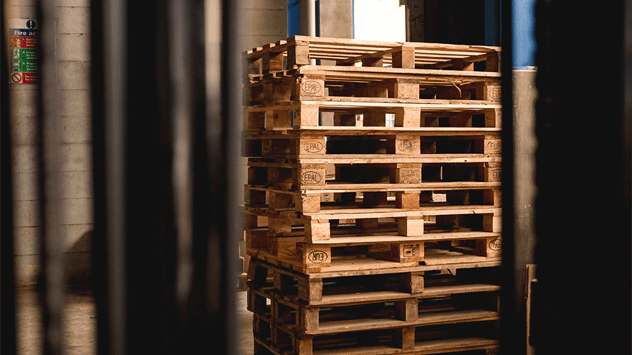
The exact type of wood a pallet is made from also varies and influences its price.
Softwoods like pine and spruce — which are relatively abundant materials — are frequently used to make pallets and are typically cheaper than hardwood pallets made from oak, walnut or maple.
Whether a pallet is made from hardwood or softwood also impacts its durability.
Hardwood pallets are more durable and dense than softwood pallets, making them less prone to damage due to heavy weight or moisture.
Because they’re relatively light, reusable, inexpensive and stable, wood pallets are used by shippers across industries from food & beverage and retail to manufacturing and construction.
Metal Pallets
Metal pallets aren’t as widely used for freight transportation as wood pallets are. That said, these pallets — which are commonly constructed of aluminum or steel — certainly fit a niche.
Metal pallets are far more durable and stiff than wood pallets, making them far less susceptible to mold, insect infestation issues and breaking/splintering under dense cargo. As a result, metal pallets can last a really long time, even if they routinely bolster heavy weights.
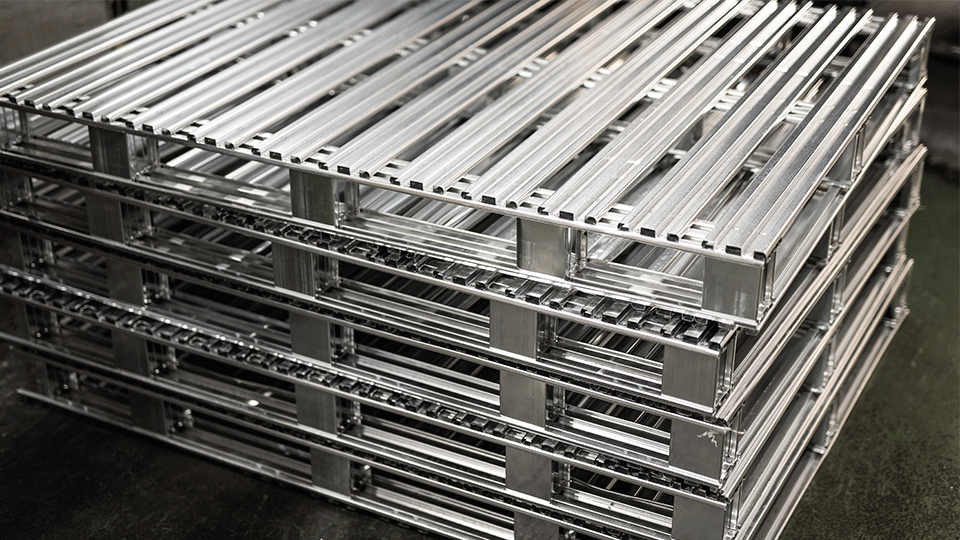
Since they’re not inexpensive ($50-$130 new), metal pallets are used by companies with specific applications for their pallets. This includes, but isn’t limited to:
- Long-term storage (both indoors and outside)
- Consistently holding heavy weights (steel pallets)
- Chemical transportation/storage
- When sterilization is frequently necessary (like with food handling/production)
Aluminum pallets, in particular, are a good option for companies that consistently ship air freight. Since they are light and durable, using an aluminum pallet can keep cargo secure while simultaneously reducing weight-related costs.
Plastic Pallets
The third and least common type of pallet used to ship freight is the plastic pallet. Typically formed from high-density polyethylene or polyurethane, plastic pallets are usually very expensive — costing up to $200 when brand new.
Plastic pallets are known for being lightweight, fairly durable, fire retardant and corrosion and odor resistant. Because they’re easy to clean and sterilize, plastic pallets are commonly for the transportation of food products — particularly those that can become unsafe for human and/or animal consumption without proper handling — chemicals and pharmaceuticals.
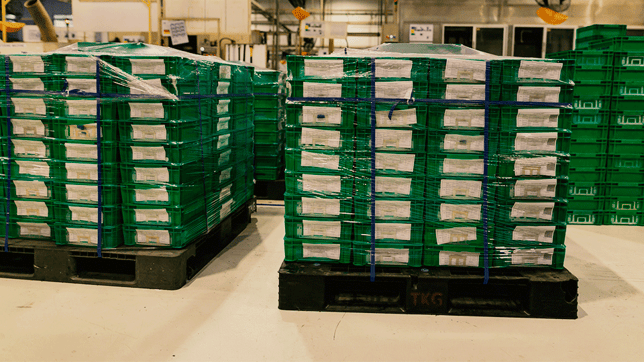
While plastic pallets are relatively durable, they can crack under heavy products. This, coupled with their price, makes them less desirable for companies in the manufacturing, construction, data center and agriculture industries (to name a few).
What Types of Pallet Designs are Commonly Used in Shipping?
Wood pallets made from hard and soft woods are by far the most commonly used pallet for freight-shipping purposes. Since they’re inexpensive, easy to recycle/replace and have endless use cases, wood pallets make up the vast majority of the pallet types used. That said, plastic and metal are also utilized.
With this in mind, there are several ways pallets (wood, steel and metal) can be designed. The two most commonly used to ship freight are:
- Block pallets
- Stringer pallets
Block Pallets
Block pallets are distinguished by the blocks comprising their middle section — between the top and bottom layers (where applicable). Within this design, sturdy blocks are located in all four corners and mid-way through each pallet segment (up to 12 blocks total). This bolsters the pallet’s top section, allowing it to support heavier freight than other types of pallets.
Although block pallets are most commonly wood, this design is also found in some plastic pallets.
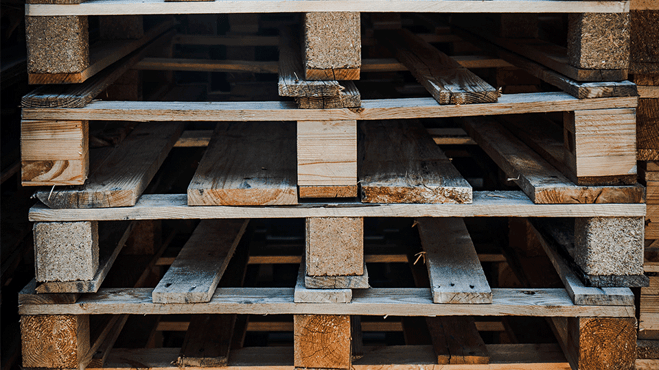
Stringer Pallets
Wooden stringer pallets are most commonly found in the U.S. Where a block pallet uses carefully-placed square blocks to hoist its top section and, by extension, the products it's carrying, stringer pallets run three to four thinner strips of material along their length — sandwiched between the top and bottom layers.
Both stringer and block pallets can either be open deck or solid deck. While open deck pallets are lighter — due to the space between their deck boards — they’re not suited for shipping smaller products and materials that could fall through their cracks. As such, if you usually ship smaller items, consider using a solid deck pallet.
What Are The Standard Pallet Sizes?
Pallets come in a mix of lengths and widths. That said, some sizes are far more common than others. In the U.S., the most common pallet dimensions are 48 inches by 40 inches — a size that was standardized by the Grocery Manufacturers of America (GMA) which is now the Consumer Brand Association (CBA).
Most 48-inch by 40-inch pallets have two to four forklift-entry points, making them easy to load and maneuver. That said, there are plenty of other pallet sizes you should be aware of and may even want to consider using.
The most common pallet sizes used to move freight in the U.S. today are:
- 48” x 40”
- 48” x 45”
- 42” x 42”
- 36” x 36”
Though they’re uncommon in U.S. truck transportation, pallets can also be:
- 32” x 48” (standard in Europe)
- 40” x 60” (standard in the UK)
- “45 x 54” (used for rail freight)
How Much Weight Can a Pallet Hold?
Depending on the design, construction, material and size of your pallet, the amount of weight you can get on it will change. What your pallet is being used for, whether it’s being lifted, moved or remaining static, will also impact its weight capacity.
Here’s a breakdown of what you can safely assume a pallet (of each makeup) can carry for freight shipping purposes:
- Plastic pallet: up to 5,000 pounds
- Steel pallet: up to 4,000 pounds
- Wooden block pallet: up to 4,600 pounds
- Wooden stringer pallet: up to 2,500 pounds
Depending on how frequently you ship heavier freight, the material of your pallets should change. For example, if you consistently max out your pallets at 4,000 pounds, a steel pallet will last far longer than a wooden pallet.
Why Does it Matter Which Pallets You Use?
The type of pallet(s) your business decides to use matters for a couple of reasons.
First, budgetarily, there’s a huge gap in pricing between purchasing wood stringer pallets and steel pallets. Additionally, heavier pallets, like those made from steel, will cost more to ship when using services with weight/density-based pricing — like LTL shipping. Make sure the pallet(s) you choose make financial sense for your business.
Second, the size and weight capacity of the pallet(s) you use, will dictate how many you can ship at one time. For example, you can realistically expect to fit 26 GMA pallets across the floor of a 53-foot dry van trailer when loading them straight.
Of course, in the right situation, turning or pinwheeling your pallets will allow you to fit more. That said, in the end, the size of the pallets you choose will dictate the number you fit within/on a trailer.
Using the Right Pallets is Only the First Step Toward Supply Chain Efficiency!
Understanding the use case for metal, plastic and wood pallets will set you on a path toward supply chain success. For example, if you have food-grade products or commodities where sanitation is really important, plastic and metal pallets could be your best option.
However, wood pallets are great for transporting most everything else. Just remember the quality/price difference between softwood and hardwood and how their construction (block, open-deck, stringer) makes a difference.
If you have any questions about your palletized freight or how its size and weight impact your less-than-truckload, partial-truckload or full-truckload freight rates, contact us here. We’re happy to answer any queries you have and set you up for success going forward.
Speaking of success. . . your next step is simple: Read this article on 5 Tips For Gaining Efficiencies in Your Transportation Supply Chain. Even though connecting your business with its best-fit pallet match is essential, there are a lot of additional things you can do to keep your inbound/outbound freight operations running smoothly.



